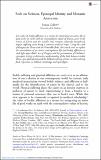Files in this item
Bede on bodily sickness, episcopal identity and monastic asceticism
Item metadata
| dc.contributor.author | Collett, Jessica Rae | |
| dc.date.accessioned | 2022-09-14T13:30:03Z | |
| dc.date.available | 2022-09-14T13:30:03Z | |
| dc.date.issued | 2022-06 | |
| dc.identifier | 280810489 | |
| dc.identifier | a0c7ee6b-2a6e-4d62-b8f7-275a4de5a336 | |
| dc.identifier | 85132041818 | |
| dc.identifier.citation | Collett , J R 2022 , ' Bede on bodily sickness, episcopal identity and monastic asceticism ' , Studies in Church History , vol. 58 , pp. 28 - 45 . https://doi.org/10.1017/stc.2022.2 | en |
| dc.identifier.issn | 0424-2084 | |
| dc.identifier.uri | https://hdl.handle.net/10023/26010 | |
| dc.description.abstract | The value of bodily affliction as a means for integrating an active life of good works on earth with the contemplative values of heaven, prior to the return of Christ and the world's end, remains relatively unexplored, despite suffering saints being a common medieval trope. Using the work of Gregory the Great and the Venerable Bede, this article seeks to explore the interrelation of an active contemplative life and bodily affliction to shed light upon Bede's use of Gregory and his presentation of Cuthbert's episcopate to forge a distinctive understanding of the links between bodily illness, episcopal identity and the biblical ordering of time, as that ordering finds expression in biblical eschatology and apocalyptic. | |
| dc.format.extent | 18 | |
| dc.format.extent | 280831 | |
| dc.language.iso | eng | |
| dc.relation.ispartof | Studies in Church History | en |
| dc.subject | BR Christianity | en |
| dc.subject | T-NDAS | en |
| dc.subject | AC | en |
| dc.subject | NIS | en |
| dc.subject.lcc | BR | en |
| dc.title | Bede on bodily sickness, episcopal identity and monastic asceticism | en |
| dc.type | Journal article | en |
| dc.contributor.institution | University of St Andrews. School of History | en |
| dc.identifier.doi | https://doi.org/10.1017/stc.2022.2 | |
| dc.description.status | Peer reviewed | en |
This item appears in the following Collection(s)
Items in the St Andrews Research Repository are protected by copyright, with all rights reserved, unless otherwise indicated.

